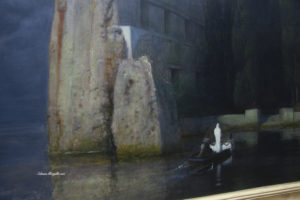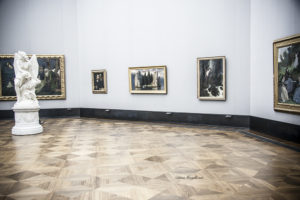Hitler’s favorite painting: The island of the Dead by Arnold Böcklin
Arnold Böcklin, born in Basel in 1827, was among the greatest exponents of German symbolism. Lover of Italy, he found very strong inspiration in Rome. He moved to the eternal city in 1850; subsequently, between 1875 to 1885, he was in Florence.
In this period, perhaps, his masterpiece was born, reproduced in five versions the famous: The Island of the Dead.
Before arriving in the collections of the Alte Nationalgalerie in Berlin (where it is possible to admire it even today) the third version made in 1883 for the art dealer Fritz Gurlitt was part of the series of personal paintings by Adolf Hitler.
This is testified by a famous photograph depicting the Führer in his studio with Molotov and Ribbentrop. (click)
In a night landscape, the emblematic figure of a character wrapped in a white tunic stands out against the light in the foreground.
It stands on a small boat, ferried by a man, explicit reference to Charon, and goes to the island which according to the most recent theory would be seen on the island of San Giorgio in Montenegro. (Other hypotheses recall a similarity with the Aragonese Castle of Ischia).
The interpretations that have been given to the painting are infinite and have contributed to feeding, even more, the enigmas it hides: Böcklin claimed to have given birth to a dreamlike image which must produce such a silence that at the knocking of the door it must be scary.
Visiting the Alte Nationalgalerie, when you find yourself in front of the opera, and you are usually always surrounded by a discreet crowd, you are dumbfounded, almost bewildered.
The artist’s intent was masterfully achieved. Everyone could look at the painting for a long time and look for a personal transposition of his unconscious. One wonders: is it simply a dream? Is it a journey to the afterlife or to an island of magical silence?
At first, it was no coincidence that the title of the work had been: Silent Island, then Island of the Tombs. With the third version, exhibited for the first time in Berlin in 1884, the name with which it became famous appeared.
All rights reserved*
Arnold Böcklin, nato a Basilea nel 1827, fu tra i massimi esponenti del simbolismo tedesco. Amante dell’Italia, trovò in Roma una fortissima ispirazione. Nella città eterna si trasferì nel 1850; successivamente, tra il 1875 al 1885, fu a Firenze.
In questo periodo nacque, forse, il suo capolavoro, riprodotto in ben cinque versioni: L’Isola dei Morti.
La terza versione eseguita nel 1883, per il mercante d’arte Fritz Gurlitt, prima di arrivare nelle collezioni dell’ Alte Nationalgalerie di Berlino (dove è possibile ammirarla anche oggi) faceva parte della serie di dipinti personali di Adolf Hitler.
Ne è testimonianza una celebre fotografia che ritrae il Führer nel suo studio con Molotov e Ribbentrop. (clicca)
In un paesaggio notturno, si staglia in controluce in primo piano, la figura emblematica di un personaggio avvolto in una tunica bianca. E’ stante su di una piccola barca, traghettato da un uomo, esplicito riferimento a Caronte, e va verso l’isola che secondo la più recente teoria sarebbe da vedersi nell’isola di San Giorgio in Montenegro. (Altre ipotesi richiamano una somiglianza con il Castello Aragonese di Ischia).
Le interpretazioni che sono state date al quadro sono infinite ed hanno contribuito ad alimentare ancora di più gli enigmi che nasconde: Böcklin asserì di aver dato vita ad un’immagine onirica la quale deve produrre un tale silenzio che al bussare della porta deve fare paura.
Visitando la Alte NationalGalerie, quando ci si trova dinanzi all’opera, e solitamente si è sempre circondati da una discreta folla, si resta interdetti, quasi spaesati.
L’intento dell’artista è stato raggiunto magistralmente. Ognuno potrebbe guardare il dipinto per lungo tempo e cercare in esso una trasposizione personale del proprio inconscio. Ci si chiede: è semplicemente un sogno? E’ un viaggio verso l’aldilà o verso un’isola dal silenzio magico?
In un primo momento non a caso il titolo dell’opera era stato: Isola Silenziosa, poi Isola delle Tombe. Con la terza versione, esposta per la prima volta a Berlino nel 1884, comparve l’appellativo con cui è diventata famosa.
InfoSite: Alte Nationalgalerie
Sostieni #laculturachevince, aiuta la condivisione.


2 Replies to “Hitler’s favorite painting: The island of the Dead by Arnold Böcklin”
Articolo fantastico che da il giusto risalto ad un capolavoro che meriterebbe molta più attenzione. Potrebbe essere il dipinto preferito di tanti altri.
Grazie Daniele per il suo commento! Spero possa trovare altri articoli di suo gradimento!